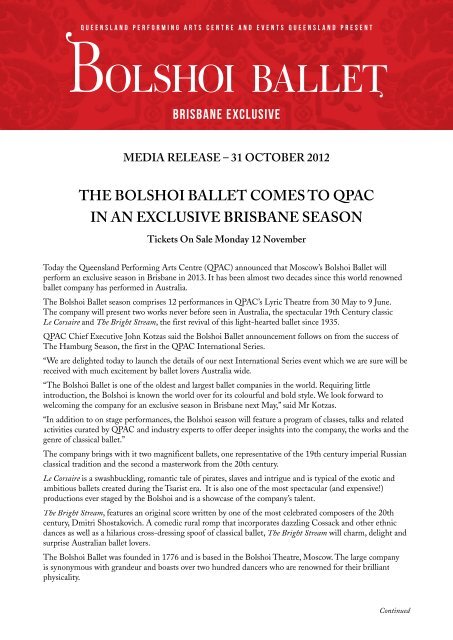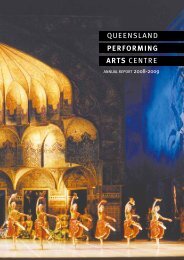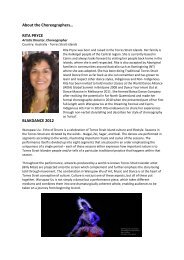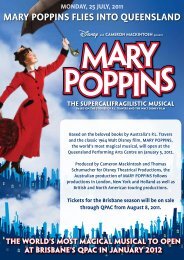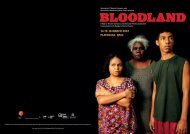Download - QPAC
Download - QPAC
Download - QPAC
Create successful ePaper yourself
Turn your PDF publications into a flip-book with our unique Google optimized e-Paper software.
QUEENSLAND PERFORMING ARTS CENTRE AND EVENTS QUEENSLAND PRESENT<br />
BRISBANE EXCLUSIVE<br />
MEDIA RELEASE – 31 OCTOBER 2012<br />
THE BOLSHOI BALLET COMES TO <strong>QPAC</strong><br />
IN AN EXCLUSIVE BRISBANE SEASON<br />
Tickets On Sale Monday 12 November<br />
Today the Queensland Performing Arts Centre (<strong>QPAC</strong>) announced that Moscow’s Bolshoi Ballet will<br />
perform an exclusive season in Brisbane in 2013. It has been almost two decades since this world renowned<br />
ballet company has performed in Australia.<br />
The Bolshoi Ballet season comprises 12 performances in <strong>QPAC</strong>’s Lyric Theatre from 30 May to 9 June.<br />
The company will present two works never before seen in Australia, the spectacular 19th Century classic<br />
Le Corsaire and The Bright Stream, the first revival of this light-hearted ballet since 1935.<br />
<strong>QPAC</strong> Chief Executive John Kotzas said the Bolshoi Ballet announcement follows on from the success of<br />
The Hamburg Season, the first in the <strong>QPAC</strong> International Series.<br />
“We are delighted today to launch the details of our next International Series event which we are sure will be<br />
received with much excitement by ballet lovers Australia wide.<br />
“The Bolshoi Ballet is one of the oldest and largest ballet companies in the world. Requiring little<br />
introduction, the Bolshoi is known the world over for its colourful and bold style. We look forward to<br />
welcoming the company for an exclusive season in Brisbane next May,” said Mr Kotzas.<br />
“In addition to on stage performances, the Bolshoi season will feature a program of classes, talks and related<br />
activities curated by <strong>QPAC</strong> and industry experts to offer deeper insights into the company, the works and the<br />
genre of classical ballet.”<br />
The company brings with it two magnificent ballets, one representative of the 19th century imperial Russian<br />
classical tradition and the second a masterwork from the 20th century.<br />
Le Corsaire<br />
is a swashbuckling, romantic tale of pirates, slaves and intrigue and is typical of the exotic and<br />
ambitious ballets created during the Tsarist era. It is also one of the most spectacular (and expensive!)<br />
productions ever staged by the Bolshoi and is a showcase of the company’s talent.<br />
The Bright Stream, features an original score written by one of the most celebrated composers of the 20th<br />
century, Dmitri Shostakovich. A comedic rural romp that incorporates dazzling Cossack and other ethnic<br />
dances as well as a hilarious cross-dressing spoof of classical ballet, The Bright Stream will charm, delight and<br />
surprise Australian ballet lovers.<br />
The Bolshoi Ballet was founded in 1776 and is based in the Bolshoi Theatre, Moscow. The large company<br />
is synonymous with grandeur and boasts over two hundred dancers who are renowned for their brilliant<br />
physicality.<br />
Continued
In October 2011 the Bolshoi Theatre reopened after a six year renovation project costing over eight hundred<br />
million dollars. When the curtain went up the audience saw a brilliant new company with a renewed<br />
energy and sensational young talent. It was as if with this glittering scarlet and gold theatre, the physical<br />
embodiment of Russia’s cultural pride was born anew.<br />
The Bolshoi Ballet season is the second in the <strong>QPAC</strong> International Series, a joint initiative by <strong>QPAC</strong> and<br />
Events Queensland.<br />
To waitlist go to qpac.com.au or phone 136 246. Tickets on sale from Monday 12 November at 9.00am.<br />
Le Corsaire<br />
“The Bolshoi’s magnificent reconstruction of Le Corsaire by Yuri Burlaka and Alexei Ratmansky proved how<br />
exciting, compelling and artistically rewarding classical ballet can be! The dancing was divine.”<br />
Network Dance, USA<br />
The Bright Stream<br />
“Alexei Ratmansky has managed to produce a work nothing short of a masterpiece.”<br />
Dance Ballet Magazine, UK<br />
To download high resolution images and video footage please go to<br />
www.qpac.com.au/bolshoi/media-centre.html<br />
<strong>QPAC</strong> Publicity<br />
Cindy Ullrich, Publicity Manager, <strong>QPAC</strong> ~ 07 3840 7589 ~ cindy.ullrich@qpac.com.au<br />
or Inga Tracey, Publicity Coordinator, <strong>QPAC</strong> ~ 07 3840 7984 ~ inga.tracey@qpac.com.au<br />
For further media enquiries please contact:<br />
Bruce Pollack, National Publicist, The Bolshoi Season at <strong>QPAC</strong><br />
Telephone: (61 2) 9331 5276 Mobile: 0418 331 527 (61 418 331 527)<br />
Email: bruce@pollackconsulting.com
QUEENSLAND PERFORMING ARTS CENTRE AND EVENTS QUEENSLAND PRESENT<br />
BRISBANE EXCLUSIVE<br />
Season Details<br />
le corsaire<br />
Opening Night<br />
Thursday 30 May 7.00pm<br />
Friday 31 May 7.30pm<br />
Saturday 1 June 1.30pm & 7.30pm<br />
Sunday 2 June 3.00pm<br />
Tuesday 4 June 7.30pm<br />
Wednesday 5 June 1.30pm & 7.30pm<br />
the bright stream<br />
Opening Night<br />
Friday 7 June 7.30pm<br />
Saturday 8 June 1.30pm & 7.30pm<br />
Sunday 9 June 3.00pm<br />
FOR BOOKINGS AND TICKET PRICES GO TO<br />
<strong>QPAC</strong>.COM.AU OR PHONE 136 246
QUEENSLAND PERFORMING ARTS CENTRE AND EVENTS QUEENSLAND PRESENT<br />
BRISBANE EXCLUSIVE<br />
The Bolshoi Ballet:<br />
big bravura dancing<br />
Written by Dr Michelle Potter<br />
When an ensemble of dancers from Moscow’s Bolshoi Ballet visited Australia in 1959 they caused a<br />
sensation. It was the first time dancers from the Bolshoi had been seen in Australia and patrons queued<br />
for hours to buy tickets or to secure standing room. Every night when the curtain went up audiences were<br />
astonished by the strength and athleticism of the dancers and by the intensity and emotional power they<br />
brought to the stage. A reputation for explosive, dramatic dancing preceded them, and they more than<br />
lived up to it. The men covered the stage with huge jumps. The women seemed to fly as they were tossed<br />
high in the air by their partners. It was big, bravura dancing and unlike anything that had been seen in<br />
Australia before.<br />
Origins<br />
The Bolshoi Ballet can trace its history back to 1776 with the formation of a private company of actors<br />
and dancers whose style of performance mixed folk dancing, mime and drama. But it was not until artists<br />
following in the footsteps of this early group, and using the same repertoire and performance style, began<br />
performing in Moscow’s New Bolshoi Petrovsky Theatre in the 1820s that the name Bolshoi (meaning big)<br />
was used to describe the company.<br />
From small beginnings the Bolshoi Ballet has come to be recognised as one of the great ballet companies<br />
of the world. A major cultural export for Russia since the 1950s, the company has brought to world-wide<br />
attention a galaxy of exceptional performers: Galina Ulanova, Maya Plisetskaya, Nikolai Fadeyechev,<br />
Ekaterina Maximova, Vladimir Va siliev, Natalia Bessmertnova, Irek Mukhamedov, Nina Ananiashvili and<br />
Andris Liepa and many others.<br />
A changing company<br />
The Bolshoi Ballet has undergone periods of dramatic change over the centuries and for the most part these<br />
changes reflect different social and political conditions. At the end of the nineteenth century the Bolshoi<br />
Ballet appeared to take second place to the ballet company located in St Petersburg. This company enjoyed<br />
the patronage of the Tsar’s court and its style of dancing was different. Moscow had its dramatic legacy while<br />
St Petersburg had a greater focus on pure dance.<br />
Following the October Revolution of 1917, however, the seat of power and patronage moved to Moscow as<br />
the capital of the Soviet Union and, although there were some specific exceptions, ballet was accepted by the<br />
Kremlin as an art form suitable for the new regime. Moreover, the Bolshoi Ballet had appointed a new ballet<br />
director in 1900, Alexander Gorsky. Gorsky and his successor, Vladimir Tikhomirov, appointed in 1924, were<br />
able to consolidate the company’s dramatic style and incorporate Communist ideology into the company’s<br />
works. A new form of ballet for the people developed, exemplified by The Red Poppy in 1927.<br />
Continued
During World War II the Bolshoi company was evacuated to Kuibyshev on the Volga. On the company’s<br />
return to Moscow, renowned dancer Galina Ulanova and choreographer and director Leonid Lavrovsky<br />
moved from St Petersburg to join the Bolshoi Ballet. Post war revitalisation of the company began. Under<br />
Lavrovsky the company made its first appearances in the West, beginning in London in 1956, followed by a<br />
major season in New York and then by the momentous Australian visit of 1959.<br />
Lavrovsky was succeeded by Yuri Grigorovich in 1964 and under his direction the Bolshoi Ballet performed<br />
large scale, spectacular ballets including a version of Spartacus in 1968, Ivan the Terrible in 1975 and<br />
The Golden Age in 1982. Grigorovich also presided over major productions of nineteenth-century classics<br />
including Swan Lake, La Bayadère, Le Corsaire and Raymonda. They were all epic productions on the<br />
grandest of scales.<br />
Into the twenty-first century<br />
A series of ballet directors followed Grigorovich. Perhaps the biggest change of all, however, came in<br />
2004 when Alexei Ratmansky was named artistic director of the Bolshoi Ballet. Ratmansky had trained<br />
in Moscow before dancing with several major Western ballet companies. He came to the Bolshoi with a<br />
growing reputation as a choreographer skilled in creating new versions of old works. For the Bolshoi Ballet<br />
he remade early Soviet works from the repertoire including The Bright Stream in 2003 and The Bolt in 2005<br />
and restaged the nineteenth-century ballet Le Corsaire in 2007 and the Soviet-era Flames of Paris in 2008.<br />
He also introduced into the Bolshoi Ballet the work of contemporary choreographers from the West,<br />
including ballets by George Balanchine, Twyla Tharp and Christopher Wheeldon.<br />
Under Ratmansky’s directorship a major rejuvenation of the company took place and the Bolshoi Ballet<br />
received many accolades for its performances in Russia, England and the United States. Ratmansky left<br />
the Bolshoi Ballet in 2008 and his shoes were filled first by Yuri Burlaka in 2009 and then by Sergei Filin<br />
in 2011.<br />
Now in 2013 the Bolshoi Ballet is still dancing with that big, bravura style that Australians saw in 1959<br />
and on several subsequent visits. Its dancers are still exuberant performers and, in addition to reflecting a<br />
chequered but distinctive history, the Bolshoi Ballet’s repertoire is still spectacularly entertaining.<br />
Not to be copied or reproduced.
QUEENSLAND PERFORMING ARTS CENTRE AND EVENTS QUEENSLAND PRESENT<br />
BRISBANE EXCLUSIVE<br />
Adolphe Adam<br />
Le Corsaire<br />
Ballet in three acts<br />
Creative Credits<br />
Premiered on June 21, 2007.<br />
Presented with two intervals.<br />
Running time: 3 hours<br />
35 minutes.<br />
Libretto by Jules Henri Vernoy de Saint-Georges<br />
and Joseph Mazilier edited by Marius Petipa<br />
Choreography: Marius Petipa<br />
Revival: Alexei Ratmansky, Yuri Burlaka<br />
New Choreography: Alexei Ratmansky<br />
Designer: Boris Kaminsky<br />
Costume Designer: Elena Zaitseva<br />
Music Director: Pavel Klinichev<br />
Lighting Designer: Damir Ismagilov<br />
Use is made in the production of music by Leo Delibes, Cesare Pugni,<br />
Pyotr von Oldenburg, Riccardo Drigo, Albert Zabel, Julius Gerber.<br />
Music dramaturgy conception — Yuri Burlaka<br />
Score restored by Alexander Troitsky<br />
The original score by Adolphe Adam/Leo Delibes for Le Corsaire has<br />
been made available by L’Opera national de Paris from the archives of<br />
La Bibliotheque nationale de France<br />
The choreographic notation has been made available by the Harvard<br />
University Theatre Collection<br />
Evgeny Ponomaryov’s costume sketches (1899) used in the production have<br />
been made available by the St. Petersburg State Theatre Library<br />
© 2000–2011 The State Academic Bolshoi Theatre of Russia
QUEENSLAND PERFORMING ARTS CENTRE AND EVENTS QUEENSLAND PRESENT<br />
BRISBANE EXCLUSIVE<br />
Le Corsaire<br />
Background<br />
Written by Valerie Lawson.<br />
Long before the age of Hollywood blockbusters, a French choreographer conceived the balletic equivalent<br />
with the spectacular Le Corsaire.<br />
The guests of honour at the premiere in Paris were Napoleon III and Empress Eugénie. When the ballet<br />
ended, the empress, a balletomane, was so entranced that she told the director of the Théâtre Impérial de<br />
l’Opéra: “I have never in my life and probably will shall never see again anything at once so beautiful and so<br />
moving”.<br />
And, she might have added, so packed with melodramatic love triangles, so many conflicts between the naïve,<br />
the good, the greedy, and the just plain evil, and a storm on stage that surpasses The Tempest.<br />
With its slave girls and pirates, its costumes of gold, turquoise, cobalt and orange, and its postcard settings at<br />
a bazaar, a cave, a seraglio, and at sea, Le Corsaire could well have inspired a swashbuckling pirate movie, from<br />
Captain Blood, starring Errol Flynn, to Johnny Depp’s Pirates of the Caribbean.<br />
But its origins lay in the 19 th century when ballets were often set in exotic locations, far from Paris – such as<br />
La Sylphide, with its Scottish setting, La Bayadere in India and Le Corsaire in Turkey. In each of these three<br />
ballets, the appearance and costumes of the locals – kilts, harem pants, turbans, or Greek skirts and boots, are<br />
incongruously paired with the classical ballet attire of tights, tutus and pointe shoes.<br />
Le Corsaire is one of the very few ballets from the mid-19 th century that is still performed today. But its<br />
longevity is not due to the story or the settings, but to the choreographic complexity, the elegance of its<br />
tableaux, and to its bravura solos, pas de deux and ensembles - all danced to the music of no less than seven<br />
composers, Adolphe Adam, Cesare Pugni, Leo Delibes, Riccardo Drigo, Pyotr von Oldenburg, Albert Zabel<br />
and Julius Gerber.<br />
The rollcall of composers is indicative of the ballet’s past. Le Corsaire premiered in France in 1856 but soon<br />
after became linked to the history of ballet in Russia, joining the select ranks of the grand classical ballets<br />
created in the 19 th century in either Moscow or St Petersburg, among them Don Quixote, Le Bayadere,<br />
Nutcracker, The Sleeping Beauty and Swan Lake.<br />
Le Corsaire was revived and restored so many times that it became a mosaic of design, choreography and score<br />
– from the production by Jules Perrot at the Bolshoi Theatre in Moscow, to Marius Petipa’s reinterpretations,<br />
including his version of 1868 when he added the deliciously romantic scene, Le Jardin Animé, and finally to<br />
Petipa’s major new production in 1899 on which all subsequent rev isions are based.<br />
By the close of the 19 th century, the work of the ballet’s original French choreographer, Joseph Mazilier, and<br />
its composer, Adolphe Adam, had all but vanished as had any tenuous connection with the inspiration for the<br />
ballet, Byron’s poem of 1814, The Corsair.<br />
Continued
Throughout the 20 th century the ballet’s home remained Russia with the companies in the West more likely<br />
to stage Corsaire excerpts such as the showy pas de deux danced by Margot Fonteyn and Rudolf Nureyev as<br />
Ali, the slave to the pirate, Conrad. The partnership of Fonteyn-Nureyev riveted audiences with the contrast<br />
between her serene beauty and his panther-like athleticism.<br />
For the Bolshoi’s present production, premiering in 2007, the choreographer, Alexei Ratmansky and the<br />
ballet master and dance reconstruction specialist, Yuri Burlaka, researched dance, design and music archives<br />
in Moscow, St Petersburg and Paris to create a Corsaire that honours Petipa’s 1899 version in choreography<br />
and décor, with the addition of Ratmansky’s own choreography.<br />
The settings, by Boris Kaminsky, suggest a 19 th century European artist’s interpretation of the exotic middle<br />
east, from the opening scene in a bazaar square in the Turkish city of Adrianople to the final tableau, recalling<br />
the romantic shipwreck paintings of Turner.<br />
Of course none of this would matter if Le Corsaire did not enchant with the dancing itself and with the<br />
two principal roles of Medora, a young Greek woman who becomes a slave to Pasha Seyd, and Conrad, her<br />
rescuer and lover.<br />
The role of Medora has been danced by many famous ballerinas, among them Anna Pavlova, Tamara<br />
Karsavina and Olga Preobrajenska, with the current generation of Bolshoi Ballet principals now excelling<br />
in both the interpretation of the heroine, and the technical skills requiring extraordinary stamina due to the<br />
length of the ballet itself as well as for her leaps and rapid turns.<br />
Conrad, a mime role in the original French production, is just as much a showcase for virtuoso male dancers<br />
whose ranks have included the Bolshoi Ballet’s artistic director, Sergei Filin, who danced the role during the<br />
Bolshoi Ballet’s tour of London in 2007.<br />
The choreographic jewel in the Corsaire crown is Le Jardin Animé in which an array of white tutu’d dancers<br />
form shapes and patterns suggesting a formal garden of flowers. Their hair and bodices are adorned with<br />
pink roses, and they hold single stems, bouquets, baskets of flowers and garlands.<br />
The scene is a ballet lover’s delight. Danced to Delibes’s waltz from the ballet, La source, ou Naila, it has<br />
nothing to do with the complex plot of Le Corsaire and everything to do with grand spectacle.<br />
As indulgent as whipped cream, Le Jardin Animé is also a meditation, reminiscent of classical ballet’s most<br />
sublime moments in which the ballerina presides over her ensemble - the swans at the lake, the shades of<br />
La Bayadere, the Wilis of Giselle, and the dryads in the dream scene of Don Quixote.<br />
Le Jardin Animé has been called “femininity as horticulture, an idea that should be offensive to a modern<br />
mind enlightened by feminism but ravishing here nonetheless”.<br />
It’s also escapism itself, and escapism in this class is one reason we go to the ballet, to abandon all logical<br />
thought, and simply indulge in a feast of dancing.<br />
Not to be copied or reproduced.
QUEENSLAND PERFORMING ARTS CENTRE AND EVENTS QUEENSLAND PRESENT<br />
BRISBANE EXCLUSIVE<br />
Le Corsaire<br />
CAST LIST<br />
30 May to 5 June, Lyric Theatre, <strong>QPAC</strong><br />
Subject to change.<br />
Medora<br />
Conrad<br />
Gulnare<br />
Birbanto<br />
Pas d’esclaves<br />
Lanquedem<br />
Seyd, the Pasha<br />
Zulmea<br />
Keeper of Seyd, the Pasha’s harem<br />
Eunuchs<br />
Danse des forbans Soloists<br />
Danse des forbans<br />
A Negress<br />
A Mufti<br />
Maria Alexandrova<br />
Ekaterina Shipulina<br />
Ekaterina Krysanova<br />
Vladislav Lantratov<br />
Ruslan Skvortsov<br />
Mikhail Lobukhin<br />
Nina Kaptsova<br />
Kristina Kretova<br />
Andrey Merkriev<br />
Denis Savin<br />
Anna Tikhomirova<br />
Denis Medvedev<br />
Chinara Alisade<br />
Andrey Bolotin<br />
Kristina Kretova<br />
Egor Simachev<br />
Alexey Loparevich<br />
Maria Zharkova<br />
Ilya Vorontsov<br />
Alexander Petukhov<br />
Sergey Minakov<br />
Anna Antropova<br />
Anastasia Meskova<br />
Anna Balukova<br />
Anna Balukova<br />
Anastasia Meskova<br />
Anna Antropova<br />
Eugene Golovin<br />
Anton Savichev<br />
Alexander Vodopetov<br />
Anastasia Vinokur<br />
Alexander Fadeechev<br />
Continued
Pas des trois Odalisques Maria Vinogradova<br />
Julia Grebenshikova<br />
Anna Tikhomirova<br />
Chinara Alisade<br />
Le Jardin Anime<br />
2 soloists Chinara Alisade<br />
Julia Lunkina<br />
Daria Khokhlova<br />
6 soloists Svetlana Pavlova<br />
Daria Khokhlova<br />
Alesya Gradova<br />
Joo Yun Bae<br />
Julia Lunkina<br />
Gnedova Svetlana<br />
Grand pas des eventailles<br />
Soloist<br />
Pas des eventails<br />
Ruslan Skvortsov<br />
Vladislav Lantratov<br />
Mikhail Lobukhin<br />
Svetlana Pavlova<br />
Julia Lunkina<br />
Voronkova Anna<br />
Svetlana Gnedova<br />
Alesya Gradova<br />
Joo Yun Bae<br />
12 corsairs Batyr Annadurdyev<br />
Alexander Vodopetov<br />
Appolinary Proskurnin<br />
Eugeny Golovin<br />
Dmitry Starshinov<br />
Alexey Tedeev<br />
Anton Savichev<br />
Ivan Semirechenskiy<br />
Victor Kleyn<br />
Egor Khromushin<br />
Maxim Oppengeym<br />
Dmitry Dorokhov<br />
Maxim Surov<br />
Denis Savin
QUEENSLAND PERFORMING ARTS CENTRE AND EVENTS QUEENSLAND PRESENT<br />
BRISBANE EXCLUSIVE<br />
Adolphe Adam<br />
Le Corsaire<br />
Ballet in three acts<br />
Synopsis<br />
Act I Scene 1<br />
Medora is Kidnapped<br />
The bazaar square. The beautiful slave-girls who are up for sale, sit awaiting buyers; here too throngs a crowd<br />
of Turks, Greeks and Armenians who are examining the wares brought from all corners of the earth.<br />
A band of corsairs appear in the square, led by Conrad. He has evidently come to the bazaar to carry out his<br />
secret plan to meet a certain beautiful stranger.<br />
Medora, the ward of bazaar-owner Isaac Lanquedem, comes out on to the balcony of her guardian’s house.<br />
Seeing Conrad, she quickly makes a selam* out of the flowers she has to hand and throws it to him. The<br />
latter, reading the selam is delighted, because now he is convinced the beautiful Medora loves him.<br />
Isaac and Medora appear in the square. While Isaac examines the slave-girls, Medora and Conrad exchange<br />
passionate and meaningful glances.<br />
A rich buyer appears in the square — Seyd-Pasha — and his suite. He is surrounded by dealers showing off<br />
their girls, but not one of the latter pleases the Pasha. Then Seyd-Pasha catches sight of Medora. He decides<br />
come what may to purchase her but Isaac refuses to sell him his ward, obsequiously explaining to Seyd-Pasha<br />
that she is not for sale and offering him instead a pair of other maidens.<br />
But Seyd-Pasha insists on buying Medora. His offers are so advantageous and attractive that Isaac is unable<br />
to resist them and agrees to the deal. Issuing an order that the new slave-girl he has just bought be delivered<br />
to his harem, Seyd-Pasha goes off, threatening Isaac with punishment if Medora is not immediately<br />
dispatched to his harem. Conrad calms down Medora, promising that the corsairs will kidnap her.<br />
At a sign from Conrad, the corsairs start a merry dance with the slave-girls, in which Medora takes an active<br />
part, to the great delight of all present. But suddenly, Conrad gives the signal, and the corsairs make off with<br />
the slave-girls and Medora too. Isaac runs after Medora and tries to snatch her from the corsairs; Conrad<br />
orders that Isaac, who is frightened out of his wits, should also be seized.<br />
Continued
Scene 2<br />
The Plotters<br />
The corsairs’ den. The corsairs, with their rich booty and captive maidens return to their lair; also brought<br />
here is the trembling Isaac. Medora, saddened by the fate of her fellow slaves, begs Conrad to free them<br />
and he agrees. Birbanto and the other pirates protest, saying that they too have a right to the women. They<br />
become mutinous. Conrad, deflecting a blow aimed at him, forces Birbanto to his knees; then he soothes a<br />
frightened Medora and carefully protecting her, goes through with her into the tent.<br />
Taking advantage of the general confusion, Isaac decides to make his escape. However he is seen by Birbanto<br />
and the other pirates who taunt him and, taking all his money, suggest that he participate in a plot to get<br />
back Medora. Picking a flower from the bunch, Birbanto sprays it with a sleeping potion, he then hands it to<br />
Isaac and tells him to give it to Conrad.<br />
Conrad appears and arranges for dinner to be served. While the corsairs are having their supper, Medora<br />
dances for Conrad who swears eternal love to her.<br />
Gradually the corsairs disperse, except for Birbanto and several of his henchmen who are keeping an eye on<br />
Conrad and Medora. Isaac now appears with a young slave-girl; pointing to Medora, he tells the slave-girl<br />
to give her the flower. Medora, clasps the flower to her breast and hands it to Conrad, adding that flowers<br />
explain all her love for him. Conrad, lovingly presses the flower to his lips but the intoxicating smell goes to<br />
his head and, despite his incredible efforts not to succumb to its effect, he immediately falls into a deep sleep.<br />
Birbanto makes a sign to the plotters to put their plan into action.<br />
Medora is taken aback at Conrad suddenly falling asleep. She is surrounded by the corsairs who threaten her.<br />
Trying to defend herself, Medora stabs Birbanto in the arm and, attempting to flee, she faints and falls into<br />
the arms of her kidnappers.<br />
Dismissing his henchmen, Birbanto is about to make short work of Conrad when the latter wakes up.<br />
Hearing that Medora has been abducted, Conrad and the corsairs set off in pursuit.<br />
Act II Scene 3<br />
The Corsair’s Captive<br />
Seyd-Pasha’s palace. The bored odalisques start playing various games. Zulma demands that the odalisques<br />
show her respect, but Gulnare and her friends mock the haughty sultana.<br />
Enter Seyd-Pasha. The odalisques are required to bow down before their master, but the unruly Gulnare<br />
mocks him too. Seyd-Pasha, carried away by her youth and beauty, throws her his handkerchief, but Gulnare<br />
throws it on to her friends, eventually the handkerchief, passing from hand to hand, reaches an old negress<br />
who, picking it up, starts to chase Seyd-Pasha, smothering him with her caresses. Seyd-Pasha is hard put to it<br />
to contain his anger.<br />
In an attempt to please the Pasha, the Keeper of the harem brings forward three odalisques. Zulma tries to<br />
attract the Pasha’s attention but, at that moment, the latter is told of the arrival of the slave trader.<br />
Catching sight of Isaac, who leads in Medora, Seyd-Pasha is overjoyed. Medora begs Seyd-Pasha to grant<br />
her her freedom but, seeing that he is unrelenting, complains of cruel treatment by her guardian; Seyd-Pasha<br />
orders the eunuch to send the Jew packing. Going up to Medora, Gulnare is kind to her and sympathizes<br />
with her lot. Seyd-Pasha offers Medora various jewels but, to Seyd-Pasha’s displeasure and Gulnare’s joy, she<br />
turns them down outright.<br />
The leader of a group of dervishes appears, who requests lodging for the night. Seyd-Pasha permits the<br />
dervishes to put up in his garden. Amused at the dervishes’ embarrassment at the sight of the young,<br />
seductive slave-girls, Seyd-Pasha promises to acquaint them with all the delights his harem has to offer and<br />
orders the slave-girls to start dancing.<br />
Among the beautiful dancing girls, Conrad recognizes his beloved.<br />
Continued
At the end of the celebration, Seyd-Pasha orders that Medora be conducted to his private rooms in the<br />
palace. Throwing off their dervish disguise, the corsairs threaten Seyd-Pasha with their daggers; Conrad and<br />
Medora embrace.<br />
The corsairs are engrossed in their plundering of Seyd-Pasha’s palace. Gulnare comes running in, pursued by<br />
Birbanto, she rushes up to Medora and begs for her help. Conrad takes Gulnare’s part, meanwhile Medora<br />
recognizes Birbanto as her kidnapper and informs Conrad of his treacherous action. Laughing, Birbanto<br />
denies her accusation; in confirmation of her words, Medora points out to Conrad the wound she inflicted on<br />
Birbanto by stabbing him in the arm. Conrad is about to shoot the traitor, but Medora and Gulnare restrain<br />
him and Birbanto runs off shouting threats.<br />
Medora, giddy with weakness and nervous tension, is on the point of fainting but, with assistance from<br />
Gulnare and Conrad, she regains consciousness and, at their request, is about to follow them when, suddenly,<br />
Seyd-Pasha’s guards burst into the hall. The corsairs are routed, Conrad is disarmed and sentenced to death.<br />
Seyd-Pasha is victorious.<br />
Act III Scene 4<br />
Seyd-Pasha’s wedding<br />
Seyd-Pasha’s private rooms in the palace. Seyd-Pasha gives orders that preparations get underway for his<br />
wedding to Medora. He proposes to Medora who indignantly turns him down. Conrad in chains is led<br />
to his execution. Medora, seeing the terrible plight of her loved one, begs Seyd-Pasha to show him mercy.<br />
Seyd-Pasha promises to pardon Conrad on the condition that Medora, of her own free will, agrees to be his.<br />
Medora is at her wit’s end and, in despair, she accepts Seyd-Pasha’s terms.<br />
Left on their own, Conrad hurries over to Medora who tells him on what condition Seyd-Pasha has agreed<br />
to free him. Conrad rejects the nefarious condition and they decide to die together. Gulnare who has been<br />
observing them suggests a plan; the lovers agree to it and thank her profusely.<br />
Seyd-Pasha returns. Medora informs him she accepts his terms. Overjoyed, Seyd-Pasha gives orders that<br />
Conrad be freed from all form of persecution and that preparations be put in hand for the wedding ceremony.<br />
The wedding procession approaches, the bride is covered by a veil. At the end of the ceremony, Seyd-Pasha<br />
gives the bride his arm, and puts a ring on her finger. The dances of the odalisques bring the wedding to<br />
an end.<br />
Left alone with Seyd-Pasha Medora tries to entice him with her dances, but it is quite obvious that she can’t<br />
wait for the hour of her delivery. Catching sight of the pistol in Seyd-Pasha’s belt, she says it frightens her<br />
and asks him to take it off. Seyd-Pasha does as he is asked and hands the pistol to Medora. Her fear increases<br />
at the sight of the dagger, also tucked in his belt. To calm her down once and for all, Seyd-Pasha pulls the<br />
dagger free and gives it to her. He then tries to embrace her but, dancing, Medora slips nimbly from his<br />
grasp. Seyd-Pasha falls at her feet and, imploring her love, gives her his handkerchief. As if for a joke, she<br />
ties his hands up with it and he, amused, laughs at her prank. On the stroke of midnight, Conrad appears.<br />
Seyd-Pasha is horrified when he sees Medora hand over his dagger to Conrad; he wants to call for help<br />
but Medora aims the pistol at him and says she will kill him if he so much as opens his mouth. Seyd-Pasha<br />
doesn’t dare utter a word, meanwhile Medor and Conrad quickly escape.<br />
Seyd-Pasha tries to free himself. Gulnare comes running in and, feigning horror, unties his hands. Seyd-<br />
Pasha summons his guard and orders them to pursue the fugitives. Three shots of the cannon bring the news<br />
that the corsairs’ ship has set sail. Seyd-Pasha has a violent fit of temper: his beloved wife has been abducted.<br />
“I’m your wife”, says Gulnare, and, pointing to her wedding finger she adds, “This is your ring!” Seyd-Pasha<br />
is left in a state of shock.
Scene 5<br />
Storm and Shipwreck<br />
At sea. A clear and peaceful night on deck. The corsairs are celebrating their liberation. Only the hapless<br />
Birbanto, in chains, does not take part in the merry-making. Taking pity on him, Medora asks Conrad<br />
to forgive Birbanto and the latter joins in her pleas. After some hesitation Conrad pardons Birbanto who<br />
requests permission to regale his fellow pirates with a barrel of wine.<br />
There is a swift change in the weather and a storm gets up; taking advantage of the confusion, Birbanto again<br />
starts to stir up trouble with the pirates, but Conrad throws him overboard. The storm gets worse: there are<br />
peals of thunder, flashes of lightning and a very rough sea. A resounding crack is heard and the ship goes<br />
aground on a rock.<br />
The wind slowly dies down and the sea becomes calm again. The moon comes out and two figures are lit up<br />
in its silvery light: these are Medora and Conrad who, miraculously, haven’t drowned. They reach the rock,<br />
clamber up onto it and thank God for their salvation.<br />
*Selam — bouquet in which each flower has special meaning. The language of flowers and communication<br />
by means of a ‘flower code’ was very popular in Europe at the end of the 18-19 centuries.<br />
© 2000–2011 The State Academic Bolshoi Theatre of Russia
QUEENSLAND PERFORMING ARTS CENTRE AND EVENTS QUEENSLAND PRESENT<br />
BRISBANE EXCLUSIVE<br />
The Bolshoi Ballet:<br />
the famous pas de deux<br />
Written by Valerie Lawson<br />
The pas de deux in Le Corsaire is one of the most famous moments in the classical ballet repertoire, yet it’s<br />
confusingly mysterious in its origins and many interpretations.<br />
From 1962, Rudolf Nureyev and Margot Fonteyn entranced audiences when they danced the showcase<br />
pas de deux, with Nureyev as Ali, the bare chested, panther-like slave, and Fonteyn as Medora, his beloved.<br />
The final pose, with Nureyev reclining on the floor, gazing at Fonteyn in adoration, said it all about their<br />
May-December partnership on stage, and possibly off stage.<br />
The male variation that forms part of the pas de deux is only a minute long, yet, with its multiple pirouettes,<br />
tucked-leg jumps and machismo poses it remains one of the most impressive and commonly performed solos<br />
at ballet competitions worldwide.<br />
The pas de deux – danced in the second scene of Act One – was a latecomer to Le Corsaire. The ballet was<br />
first choreographed by Joseph Mazilier in 1866 in Paris, and adapted by Jules Perrot two years later in Russia.<br />
But dance historians believe that the pas de deux made its first appearance in 1899 when Marius Petipa<br />
staged the final version of his many productions of the ballet in St Petersburg.<br />
More recent research suggests that the pas de deux was first danced in 1915, when the ballet master,<br />
Samuil Andrianov, staged a production at the Mariinsky Theatre, St Petersburg.<br />
Just to add more confusion, this interpolated dance was really a ‘pas de deux à trois’ for Medora, Conrad,<br />
the pirate, and a second suitor, who had danced in the Pas d’Esclave (Slave Dance) in the first scene of Act I.<br />
However, the slave was unnamed until the Soviet era. The cast list for a production staged in Russia by<br />
Agrippina Vaganova in 1936 shows him as “Rhab”.<br />
In 1955, for a new version of the ballet for the Maly Theatre Ballet in St Petersburg, the slave became “Ali”.<br />
Over time, only Ali danced the pas de deux with Medora and it was this version that Nureyev brought to the<br />
West after he defected from the Soviet Union in 1961.<br />
For his revival of Le Corsaire for the Bolshoi Ballet in 2007 Alexei Ratmansky has gone back to Petipa’s 1899<br />
production but there is no Ali. The pas de deux is danced by Medora and Conrad in the setting of a grotto,<br />
the den of the pirates.<br />
No matter how it is staged, the pas de deux always retains its wow factor as one of the major highlights of<br />
Le Corsaire.<br />
Not to be copied or reproduced.
QUEENSLAND PERFORMING ARTS CENTRE AND EVENTS QUEENSLAND PRESENT<br />
BRISBANE EXCLUSIVE<br />
Dmitry Shostakovich<br />
The Bright Stream<br />
Comic ballet in two acts<br />
Creative Credits<br />
Premiered on April 18, 2003.<br />
Presented with one interval.<br />
Running time: 2 hours 5<br />
minutes.<br />
Libretto by Adrian Piotrovsky and Fyodor Lopukhov<br />
Choreographer: Alexei Ratmansky<br />
Designer: Boris Messerer<br />
Music Director: Pavel Sorokin<br />
Lighting Designer: Alexander Rubtsov<br />
© 2000–2011 The State Academic Bolshoi Theatre of Russia
QUEENSLAND PERFORMING ARTS CENTRE AND EVENTS QUEENSLAND PRESENT<br />
BRISBANE EXCLUSIVE<br />
The Bright Stream<br />
Background<br />
Written by Valerie Lawson.<br />
Dancing farmers, a tractor driver, a man on a bicycle dressed as a dog and another in drag as a sylph in pointe<br />
shoes, all cavorting against a backdrop of golden sheaves of wheat on a collective farm.<br />
How could these be among the cast of characters in The Bright Stream, a ballet that first arose under the<br />
tyrannical leadership of Joseph Stalin?<br />
The transformation of this Soviet-era ballet of the 1930s into a joyous and comic ballet that has charmed<br />
audiences in Moscow, London and New York in the last decade is all due to one man, the acclaimed<br />
choreographer, Alexei Ratmansky.<br />
Born in St Petersburg and trained as a dancer in Moscow, Ratmansky is steeped in the history of Russian<br />
ballet and the work of Russian composers, and in particular, Dimitri Shostakovich. So in 1995 when he first<br />
heard the composer’s score for a long forgotten ballet, called The Limpid Stream, he was entranced.<br />
“It sounded incredible”, he said. “I couldn’t believe that no one had returned to it before. The music is just<br />
so danceable, with this wonderful variety of adagios, waltzes and polkas. It’s like [Ludwig] Minkus but all on<br />
the level of Shostakovich’s genius”.<br />
The choreographic notation of the 1935 ballet was nowhere to be found. But in 2003, using the original<br />
libretto and music, Ratmansky staged his reconstruction of the original Limpid Stream for the Bolshoi Ballet<br />
in Moscow.<br />
Renamed The Bright Stream, the ballet is set at a harvest festival at a collective farm in the north of Russia,<br />
complete with happy workers intermingling with a visiting troupe of ballet dancers from the city.<br />
Ballets featuring festival celebrations are not uncommon, (Coppelia, Flower Festival at Gennaro, for example),<br />
but a collective farm festival was an extremely radical and in retrospect, a dangerous idea in the 1930s – even<br />
though the creators of The Limpid Stream – the librettist, Adrian Piotrovsky, the choreographer, Fyodor<br />
Lopokov and the composer, Shostakovich - had no idea at the time of the terrible outcome of Stalin’s<br />
collective farm project. The forced confiscation of individually owned private farms, an era known as “the<br />
second serfdom”, led to the exile or death of many farmers who resisted.<br />
With its witty scenario and danceable score, The Limpid Stream was a critical success when it premiered at<br />
the Maly Theatre in Leningrad. As Ratmansky recalled: “All the critics raved about new horizons opening up<br />
and about this being the first major success of Soviet ballet”.<br />
But in January 1936, when the ballet transferred to the Bolshoi Theatre in Moscow, the edifice came<br />
crumbling down on their heads.<br />
Continued
An editorial in Pravda labelled it a “balletic fraud”, with its depiction of socialist peasants as “sugary paysans<br />
from a pre-revolutionary chocolate box”.<br />
As Judith Mackrell wrote in her biography of the ballerina, Lydia Lopokova, sister of Fyodor Lopokov, “the<br />
only artistic crime apparently committed [by the choreographer and librettist] was to put the ballet’s cast of<br />
farmworkers in pointe shoes, and to show them performing classical steps rather than ‘local folk dances and<br />
games’; yet as a result, the librettist, Adrian Piotrovsky was sent to the gulag (from which he never returned)”.<br />
Even before the premiere of The Limpid Stream, Shostakovich was out of favour with Stalin who hated his<br />
Lady Macbeth of Mtsensk, an opera ridiculed by the newspaper, Pravda, as a “confused stream of sound”<br />
filled with “quacks, grunts, and growls”. Just one week after this denunciation, Pravda went in for the kill,<br />
describing the score for The Limpid Stream as “music without character”. Shostakovich never wrote another<br />
ballet score.<br />
As for Lopokov, newly promoted as director of the Bolshoi Ballet, he was stripped from the role and his<br />
career almost came to an end.<br />
Many years later, Ratmansky’s rescue of Lopokov’s reputati on was an important factor in his recreation of the<br />
ballet and it’s easy to see him as a successor to Lopokov in his love of narrative, his fascination with Russian<br />
history and social life, and his love of the work of Shostakovich.<br />
Asked by The New York Times what draws him to the music of Shostakovich, Ratmansky said: “He’s very<br />
Russian. You can learn the history of the country from his music. He was very sensitive, very true, even if he<br />
had to have a mask on. Like Dostoyevsky and Tolstoy, on that level of diving deep into the soul and the time.<br />
His music answers so many questions.<br />
“He was the child of the Russian avant-garde, super brave and grotesque, almost evil. And then in the ’30s he<br />
went through such pressure, it crushed his self-importance. He expected arrest every night. His friends and<br />
relatives were arrested and killed. It changed his ideas of what the artist should be”.<br />
Although Ratmansky has been artist-in-residence at American Ballet Theatre in New York since 2008, his<br />
choreography continues to honour the legacy of his Russian predecessors, such as Leonide Massine, who<br />
danced at the Bolshoi before joining Diaghilev’s Ballets Russes where he carried on the Bolshoi traditions<br />
of character dancing, mime, and comedy in ballets such as Gaité Parisienne and Scuola di ballo (the last rechoreographed<br />
by Ratmansky for The Australian Ballet in 2009).<br />
The Bright Stream, in particular, is built around character and demi-character roles of the kind that enlivened<br />
the ballets of the English choreographers, John Cranko and Frederick Ashton.<br />
Just as Ashton’s Cinderella features men in drag as the Ugly Stepsisters, and the ladies of Portsmouth in<br />
Cranko’s Pineapple Poll disguise themselves as sailors to go searching for desirable captain of HMS Hot<br />
Cross Bun, Ratmansky’s Bright Stream features cross dressing, a tangled web of confused identities, and a<br />
semi-farcical plot as complex as The Marriage of Figaro and A Midsummer Night’s Dream.<br />
The story unfolds against Boris Messerer’s sets of harvest produce and wheat with the ballet’s colourful<br />
array of roles including an accordion player who chases a schoolgirl, Zina, the entertainment director of<br />
the collective farm, called The Bright Stream, Zina’s husband, Pyotr, an agricultural student enchanted by<br />
the visiting Ballerina, her partner, the Ballet Dancer, and an Old Dacha Dweller and his wife, titled The<br />
Anxious-to-be-younger-than-she-is-Dacha Dweller.<br />
Among all the carnival-like festivity and vaudevillian pranks, the leading dancers perform virtuoso solos and<br />
pas de deux that are all the more impressive as the Ballerina and her partner dance very convincingly as the<br />
opposite sex.<br />
Like Maurice Béjart’s Le Concours and Jerome Robbins’s The Concert, The Bright Stream makes jokes about<br />
ballet – its mannerisms and outdated concepts of fragile women, lovesick men and happy ever aftering. But<br />
the only successful jokes about ballet are made by the men and women who love the art form the most.<br />
Ratmansky is clearly among them.<br />
Not to be copied or reproduced.
QUEENSLAND PERFORMING ARTS CENTRE AND EVENTS QUEENSLAND PRESENT<br />
BRISBANE EXCLUSIVE<br />
The Bright Stream<br />
CAST LIST<br />
7 to 9 June, Lyric Theatre, <strong>QPAC</strong><br />
Subject to change.<br />
Zina<br />
Pyotr<br />
Ballerina<br />
Ballet Dancer<br />
Accordionist<br />
Old Dacha Dweller<br />
Anxious-To-Be-Younger-Than-She-Is Dacha Dweller<br />
Galya<br />
Gavrilich<br />
Milkmaid<br />
Tractor Driver<br />
Highlander<br />
Field Worker from Kuban<br />
Highlanders<br />
Fieldworkers from Kuban<br />
Zina’a friends<br />
Nina Kaptsova<br />
Ekaterina Krysanova<br />
Andrey Merkuriev<br />
Mikchail Lobukhin<br />
Maria Alexandrova<br />
Ekaterina Shipulina<br />
Ruslan Skvortsov<br />
Vladislav Lantratov<br />
Denis Savin<br />
Denis Medvedev<br />
Alexey Loparevich<br />
Alexander Petukhov<br />
Anastasia Vinokur<br />
Anna Antropova<br />
Ksenia Pchelkina<br />
Anna Proskurnina<br />
Egor Simachev<br />
Alexander Petukhov<br />
Anastasia Meskova<br />
Anna Antropova<br />
Andrey Bolotin<br />
Denis Medvedev<br />
Alexander Vodopetov<br />
Maxim Surov<br />
Batyr Annadurdyev<br />
Alexey Matrakhov<br />
Anton Savichev<br />
Roman Simachev<br />
Dmitry Zhuk<br />
Anton Kuznetsov<br />
Egor Sharkov<br />
Sergey Minakov<br />
Andrey Rybakov<br />
Chinara Alisade<br />
Maria Vinogradova<br />
Julia Lunkina<br />
Svetlana Pavlova<br />
Daria Gurevich<br />
Daria Khokhlova
QUEENSLAND PERFORMING ARTS CENTRE AND EVENTS QUEENSLAND PRESENT<br />
BRISBANE EXCLUSIVE<br />
Dmitry Shostakovich<br />
The Bright Stream<br />
Ballet in two acts<br />
Synopsis (historical text)<br />
Act I Scene 1<br />
A small wayside halt, in the steppes, on one of the branch lines of the North Caucasian Railway. Early<br />
autumn. The local collective farms have completed both their harvesting and autumn sowing.<br />
A brigade of artistes from one of the capital’s theatres is due to arrive in the region to take part in the harvest<br />
festival, marking the end of the field work. Some members of the nearest collective farm, The Bright Stream,<br />
have come to the halt to welcome their guests. They include the collective farm activist, Gavrilych, who,<br />
though advanced in years, is full of the joys of life and a general favorite; the school-girl Galya, and some of<br />
her friends, with a bunch of flowers for the artistes; Pyotr, an agricultural student and his wife Zina, a local<br />
amusements’ organizer. The last to arrive are two dacha dwellers: an elderly man and his anxious-to-beyounger-than-she-is<br />
wife. Both of the latter, bored to tears, have come to gawk at the visiting artistes. While<br />
waiting for the guests to arrive, the dreamy and thoughtful Zina buries her head in a book. Her husband,<br />
Pyotr, who is of a cheerful, buoyant disposition, tries to distract her, inducing the others to share in his<br />
efforts. Eventually all, except Zina, proceed to the platform. The excited crowd returns, together with the<br />
artistes — a ballet dancer, her partner and an accordion-player.<br />
The amusements’ organizer, Zina, hails the ballet dancer who stops in her tracks. They recognize each<br />
other as old friends, for they once studied together at ballet school. Since then Zina has married Pyotr, the<br />
agricultural student, and has gone to work with him on the collective farm where no one has any idea that<br />
she used to be a dancer. The two friends, who have remained alone, gaze at each other with curiosity.<br />
The ballerina asks if Zina has forgotten her dancing. But, living in the country, she has not forgotten her<br />
dancing skills and intends to prove it. The two friends, compete with each other, trying to see who can<br />
remember the most of their former lessons. Gavrilych and Pyotr now appear: they have come to fetch Zina<br />
and the ballerina. Zina introduces her husband to the ballerina. Dazzled by the ballerina, Pyotr begins to<br />
court her. The latter feels her first pang of jealousy.<br />
Continued
Scene 2<br />
The day is on the wane. Encamped among the golden sheaves of wheat, a field workers’ brigade from The<br />
Bright Stream collective farm joyfully makes plans for tomorrow, which is to be a day of festival. The artistes’<br />
brigade arrives. Gavrilych presents them to the field workers’ brigade.<br />
The two brigades greet each other. An improvised celebration gets underway. The artistes display the<br />
presents they have brought with them for distribution to the collective farm’s best shock workers. There is<br />
a gramophone for Gavrilych, a silk dress for the best milkmaid. The prizewinners are lustily congratulated,<br />
and the jollity merges into a dance. The first to break into a dance are the grey-haired, bearded ‘inspectors of<br />
quality’ and their Gavrilych.<br />
The dacha dwellers turn up, late as usual. They are forced to trip a measure and, by way of a joke, they dance<br />
an ancient Chaconne. Then comes a number by some young girls, members of an amateur group organized<br />
by Zina. But it is the milkmaid who is the center of attention: they want to see her dance in her smart, new<br />
dress. The milkmaid dances with the tractor driver. The merriment increases. Gavrilych winds up his new<br />
gramophone and asks the guest artistes to dance.<br />
Not wishing to disappoint the collective-farm workers, the artistes agree though they dislike the idea of<br />
dancing in their ordinary clothes. They improvise a dance among the wheat sheaves. Their dance gets a<br />
mixed reception. The farm workers watch it with pleasure, but the dacha dwellers only have eyes for the<br />
artistes themselves (the husband is taken by the classical ballerina, while his wife is attracted by the ballerina’s<br />
partner). Zina is jealous of her husband. Pyotr, the young agricultural student, is more and more enchanted<br />
by the ballerina who seems so brilliant and talented by comparison to his modest, unassuming wife.<br />
The accordionist is asked to join in the dancing with schoolgirl Galya. Now some young field workers from<br />
Kuban and the Caucasus burst into a gay, warlike dance which enthralls all present. The merriment reaches<br />
its height. Eventually, the assembled company is invited to partake of refreshment. As all make their exit,<br />
the old dacha dweller manages to whisper in the visiting ballerina’s ear that he would like to see her again,<br />
his wife makes a similar proposal to the latter’s partner. Meanwhile, Pyotr goes off with the ballerina. Zina<br />
is totally distraught, she even starts to cry. The young people, together with Gavrilych, try to calm her down.<br />
But now the ballerina returns and assures Zina that she has no intention of flirting with the latter’s husband.<br />
She suggests that Zina tell the young people that she too used to be a dancer.<br />
Zina agrees and again the two friends dance together. There is general astonishment. The ballerina proposes<br />
that a joke be played on Pyotr and the others: she will dress up in her partner’s costume and go and meet<br />
the anxious-to-be-younger-than-she-is dacha dweller’s wife. Her partner, made up as a female dancer, shall<br />
go to the rendezvous with the old dacha dweller. While Zina shall go to meet her husband in the ballerina’s<br />
costume. The plan is approved.<br />
Act II Scene 3<br />
A warm, southern night. A clearing, surrounded by bushes and trees. The young people have assembled.<br />
The dacha dwellers turn up too, late as usual. The accordionist has taken a fancy to Galya, the schoolgirl,<br />
who had danced with him so merrily earlier in the day. He whispers to her that he will soon be back and<br />
that she should wait for him. Galya is quite taken aback. The old dacha dweller, his wife and Pyotr remind<br />
their ‘sweethearts’ of their trysts. The young people are now determined to teach them a lesson. They quickly<br />
dress up: the ballerina in her partner’s clothes, the latter in female dress, Zina in one of her friend’s theatrical<br />
costumes. To add to the fun, the tractor driver puts on a dogskin. All is ready. Now Galya admits that the<br />
accordionist has invited her to a rendezvous too.<br />
This revelation threatens to ruin their carefully laid plans, but the tractor driver comes to the rescue. He<br />
suggests to Galya that she should meet the accordionist as the latter had proposed, but that he, the tractor<br />
driver, disguised as a dog, will not allow the accordionist to approach her. His plan is agreed. Galya, attended<br />
by Kolka-‘the dog’, waits for the accordionist. He appears and is much put out by the uncalled-for presence<br />
of the dog which seems very fierce and keeps on attacking him. Finally, the accordionist realizes he is being<br />
made a fool of but, taking it in good part, he joins in the main plot.<br />
Continued
The elderly dacha dweller turns up, wheeling a bicycle. He wants to make a good impression on the ballerina<br />
and has donned sporting gear. He is festooned with a gun, ammunition belt and telescope. The thought<br />
of the forthcoming meeting excites him. His wife turns up at the same spot. She is wearing ballet shoes to<br />
surprise the male dancer. It is time to put the plan in action. Suddenly, the dacha dweller catches sight of<br />
his beautiful ballerina, his Sylphide, in the middle of a clump of trees. It is in fact the ballerina’s partner, in<br />
female garb, but the old man does not notice this. His wife, who is observing him, objects to his flirting and<br />
chases off her husband. But she, in turn, is frightened by the tractor driver who, still in his dogskin, is riding<br />
the bicycle. Appearing in her partner’s costume, the ballerina mocks the dacha dweller’s wife. Finally, they<br />
both run off.<br />
Enter Pyotr, the agricultural student. He is waiting for the dancer from the distant capital, but instead, he<br />
is met by his own wife, disguised as the dancer. He fails to recognize her. Joking and flirting with him, Zina<br />
disappears into the bushes. This lyrical scene gives way to slapstick. The old dacha dweller and male dancer<br />
disguised as the ballerina now come running in. ‘Romantic passions’ reach an all-time high. The ballerina,<br />
dressed in male clothing, comes out from behind the bushes, and makes a scene. She demands satisfaction<br />
from the dacha dweller. There follows a comic duel. The first to fire is the disguised ballerina. She misses.<br />
Now the old dacha dweller is handed a pistol. Though he is frightened, he takes aim. Simultaneously,<br />
Gavrilych bangs a pail, and the old man thinks he has fired. Immediately the ballerina’s partner falls to the<br />
ground as though shot. The horrified dacha dweller takes to his heels. No sooner has he disappeared, than<br />
the ‘victim’ comes to life and dances amid the laughter of the delighted plotters.<br />
Scene 4<br />
The beginning of the morning of the following day. The harvest festival. In the meadow, an improvised stage<br />
for the artistes. All the seats are taken. Pyotr, the agricultural student, is waiting on tenterhooks for the show<br />
to begin so that he can see the ballerina whom (he thinks) he met last night in the woods.<br />
But to his great astonishment two dancers, dressed exactly alike, appear on stage, their faces hidden by masks.<br />
Their dance over, Pyotr, unable to restrain himself, rushes towards them. They raise their veils and the secret<br />
is out. Pyotr, who sees one of the ballerinas is his wife, timidly begs her forgiveness. Eventually they are<br />
reconciled. Pyotr has learnt his lesson: he now knows that his modest Zina is both a first-class worker and<br />
a marvelous ballerina. The festival ends with a general dance in which alt young and old take part, together<br />
with the guest artistes.<br />
© 2000–2011 The State Academic Bolshoi Theatre of Russia


